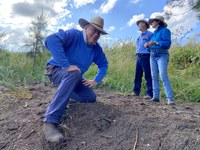Upper Mooki Rehydration Project
On 25 June 2020, the Upper Mooki Landcare group proudly launched the ‘Upper Mooki Rehydration Project’. This innovative, catchment-wide hydrology project focuses on soil as a ‘sponge’ in the landscape and is one of only a few of its type in Australia.
A total of 21 landholders are joining forces and partnering with the North West Local Land Services on the $660,000 initiative. The project is focused on retaining water in the land, rather than only considering water supplies on the land, such as in dams, creeks and rivers.
“The Upper Mooki catchment is a very broken system and we’re aiming to bring back its hydrological function. We are slowing the passage of water through the landscape so that moisture is retained in the soil, leading to a healthier catchment and greater farm productivity” said Craig Carter, one of the participating farmers and brainchild of the project.
The 12-month project will help to build the capacity of local landholders to survive and thrive during droughts; growing food and fibre whilst looking after the natural environment. Members of Upper Mooki Landcare group will carry out activities that will regenerate the water holding capacity and functions of the soil profile.
Activities taking place across 13 farming enterprises include earthworks such as swales, contour banks and ‘leaky dams’, fencing, changes to cropping and grazing practices and revegetation to increase groundcover.
Myles Sevil, farms on 725 hectares at ‘Hillview’ near Willow Tree, usually running 2,000 breeding ewes. In the past he had problems with the speed of water travelling through and leaving his property.
“In my steep country, sheep tend to track down to the watering point and in a big storm, that little track would turn into a gully. Normally in those heavy storms we would see water come into the gully and then continue on down to a contour bank and into the creek and there’d be a rush of brown water, carrying off silt.”
As part of the Upper Mooki Rehydration Project, Mr Sevil employed a local contractor to construct a series of swales, or shallow channels, on a hillside leading to several leaky dams. These dams not lined with clay but have a rocky bottom so that water drains out into the landscape as well as through poly pipe installed in the dam.
Mr Sevil said the benefits of the earthworks, combined with his grazing practices were visible after recent rain.
“With the enhanced groundcover and the leaky dams, the volume of water entering the creeks leaving my place is not as much as previously. I’ve noticed that it is soaking in and we’re retaining moisture on the place.”
Maddy Pursehouse and her husband run a cattle trading business on their 1600 hectare property Rothesay.
As part of the project, they have installed stock-proof fencing to keep cattle out of the two creeks that run through the property to promote better groundcover and natural regeneration of casuarinas.
“Having more plants and diversity of groundcover will slow down the water and the trees that grow in the creeks catch debris, topsoil and seed and slow down the movement of water,” Ms Pursehouse explained.
Ms Pursehouse said she is passionate about soil health and rehydrating the landscape but it also makes good business sense.
“At the end of the day if we can keep more water on the farm, we can grow more grass, we can run more livestock and be more profitable. The whole aim of regenerating the farm is improve it for future generations so we can pass it on to our kids in a better state than when we bought it.”
North West Local Land Services Project Lead, Angela Baker, said as part of the project, the participating farmers will do before and after benchmarking in order to assess the changes. “The project requires them to share the results and a number of workshops or on-farm events are planned, to help build capacity among farmers more widely”.
The Upper Mooki Rehydration Project is supported by North West Local Land Services through funding from the NSW government’s Catchment Action NSW and a contribution from the Australian Government’s National Landcare Program.
Participating farmers were required to match the contributions from the funding bodies, along with in-kind support from charity, Starfish Initiatives.
Quick Facts about Upper Mooki Rehydration Project • Cost of $660,000 (over $330,000 in Government funding and the remainder in in-kind and cash contributions from landholders) • 21 participating landholders on 13 enterprises • Work to be carried out across more than 2,700 ha including revegetation and pasture plantings, earthworks entailing absorption banks, swales, sill spills and riparian works • 41.5 km of new stock and riparian corridor fencing • Employment of local earthmoving, fencing and other contractors • Establishment of 26 watering points and laying of 10 km of piping • Peer to peer mentoring supported by experts y • Research, partnerships and education of the importance of landscape hydrology to continue beyond the year-long project • Review and update of Upper Mooki Landcare's five-year Strategic Plan. Adapted from content which first appeared on www.lls.nsw.gov.au, 25 June 2020.







